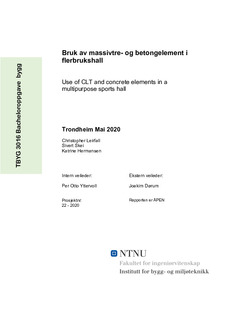Bruk av massivtre- og betongelement i flerbrukshall
| dc.contributor.advisor | Yttervoll, Per Otto | |
| dc.contributor.advisor | Dørum, Joakim | |
| dc.contributor.author | Leirfall, Christopher | |
| dc.contributor.author | Skei, Sivert | |
| dc.contributor.author | Hermansen, Katrine | |
| dc.date.accessioned | 2020-06-20T16:00:47Z | |
| dc.date.available | 2020-06-20T16:00:47Z | |
| dc.date.issued | 2020 | |
| dc.identifier.uri | https://hdl.handle.net/11250/2658911 | |
| dc.description.abstract | Formålet med denne oppgaven er å sammenligne egnetheten til massivtre og betong som byggemateriale i en idretts-/flerbrukshall. For å gjøre denne sammenligningen tas det utgangspunkt i en yttervegg av massivtre i en eksisterende idrettshall. Denne ytterveggen sammenliknes med en tilsvarende vegg i prefabrikkert betong som er tegnet utelukkende for dette formålet av Overhalla Betongbygg. Egnetheten til materialet vurderes basert på følgende kriterier: bygningsfysiske egenskaper, kostnad og klimafotavtrykk. Resultatene viser at de bygningsfysiske egenskapene som skiller ytterveggene fra hverandre er brannmotstand og klanglyd. Betongveggen er et sikrere brannteknisk valg, men ytelseskrav for brannsikkerhet innfris også for massivtreveggen. Klanglyd er en utfordring for begge materialene, men det kreves flere tiltak for å redusere etterklangstiden for betongelementet. Både massivtre- og betongveggen har fordeler og ulemper tilknyttet etterklang og brannsikkerhet, men disse utfordringene ansees ikke som utslagsgivende for valg av byggematerial. Det konkluderes derfor med at valg av byggemateriale heller burde tas på bakgrunn av kostnad og klimafotavtrykk. Resultatet av kostnadsanalysen viser at enhetsprisen for massivtreveggen er lavere enn for betongveggen. Klimagassregnskapet viser også at massivtre har lavest utslipp av CO2e gjennom levetiden. | |
| dc.description.abstract | The purpose of this thesis is to compare the level of suitability for CLT and concrete when it is used as building materials in sports halls. In order to create a basis for the comparison, two exterior walls where analysed. One of the walls is an existing wall which consists of CLT, whilst the other one consists of concrete, and is sketched solely for the purpose of this thesis. The determination of suitability for the materials is based on the following criteria: the buildings physical properties, a calculation of costs and a life-cycle assessment (LCA), which is a methodology for assessing environmental impacts. The results show that fire resistance and sound quality set the materials apart from each other. Concrete is a safer choice when it comes to fire resistance, but the fire safety performance requirements can still be met with the use of CLT. Both materials, however, have challenges related to echoing, seeing as how the hall is made up by a great empty volume. Still, it is easier to cope with the acoustic challenges using CLT, because it has a softer surface. Although there are advantages and disadvantages to both CLT and concrete, this is not considered to be decisive for the choice of material. Therefore, it is concluded that the choice of building material should rather be based on the results of calculated cost and climate footprint. The results of the calculation of costs show that the wall consisting of CLT has the lowest unit prize. Also, the LCA show that CLT has less emission of CO2 eq during its lifetime. | |
| dc.publisher | NTNU | |
| dc.title | Bruk av massivtre- og betongelement i flerbrukshall | |
| dc.type | Bachelor thesis |
